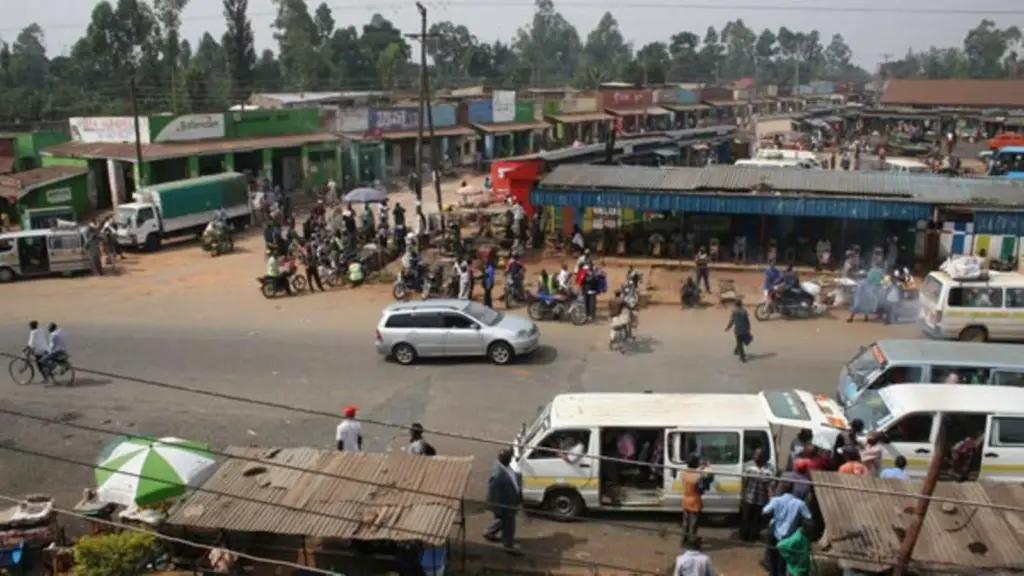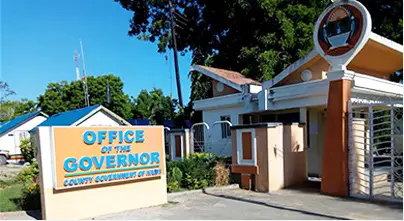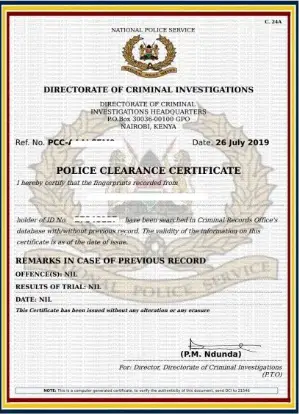If you’re looking to explore Kenya beyond the typical tourist destinations, Luanda town is a great place to start. Located in the Vihiga County, Luanda is a bustling market town that has grown significantly over the past decade.
It is situated along the Kisumu-Busia highway and is home to several banks and supermarkets, making it a hub of activity for both locals and visitors.
Luanda town has a rich history and culture that is worth exploring. The town’s name comes from the granite rocks that dot the land, which were believed to have been used by the Banyore people for spiritual purposes.
Today, Luanda is inhabited by the Banyore, a sub-tribe of the larger Luhya community. If you’re interested in learning more about the town’s history and culture, there are several museums and cultural centers that offer guided tours and educational programs.
In addition to its cultural attractions, Luanda town is also known for its natural beauty. The town is surrounded by lush green hills and is home to several bodies of water, including Dunga Bay.
If you’re interested in outdoor activities, there are several hiking trails and nature reserves in the area that offer breathtaking views of the surrounding landscape.
Whether you’re looking to immerse yourself in the local culture or simply enjoy the natural beauty of Kenya, Luanda town is a destination worth exploring.
Geographical Location
Luanda is a small town located in the Vihiga County of Kenya. It is situated along the Kisumu-Busia highway and is a significant business point in Bunyore. As of 2019, the town has a population of 13,319 people.
Luanda is located a few kilometers from the Equator at Maseno, with its geographical coordinates being 0° 0′ 0″ North, 34° 35′ 0″ East. The town is situated at an elevation of 1501 meters above sea level.
The climate in Luanda is classified as tropical, with an average temperature of 22.8 °C. The town experiences two rainy seasons, the long rains from March to May and the short rains from October to December. The average annual rainfall is 1,351 mm.
Luanda is surrounded by several hills, including the Bunyore, Maragoli, and Kisa hills. The hills provide a scenic view of the town and its surroundings. The town is also situated near the Yala River, which is a major source of water for the residents of Luanda and the surrounding areas.
The table below summarizes some of the key geographical information about Luanda:
| Geographical Information | Value |
|---|---|
| Latitude | 0° 0′ 0″ North |
| Longitude | 34° 35′ 0″ East |
| Elevation | 1501 meters above sea level |
| Climate | Tropical |
| Average Temperature | 22.8 °C |
| Rainy Seasons | March to May, October to December |
| Average Annual Rainfall | 1,351 mm |
| Surrounding Hills | Bunyore, Maragoli, Kisa |
| Nearby River | Yala River |
History of Luanda Town
Luanda Town is located in the Vihiga County of Kenya and has a rich history that dates back to the pre-colonial era. The original inhabitants of the area were the Wanga people, who were known for their agricultural practices and trade with neighboring communities.
During the colonial era, Luanda Town served as a center for the British colonial administration in the region. It was also an important trading center, where goods such as coffee, tea, and cotton were traded. The town was connected to other parts of the country by a railway line that passed through the area.
After Kenya gained independence in 1963, Luanda Town continued to grow and develop. The town became an important center for education, with several schools and colleges being established in the area. It also became a hub for small-scale industries, such as textile and food processing.
In recent years, Luanda Town has undergone significant changes, with the construction of modern buildings and infrastructure. The town has also become a popular tourist destination, with several attractions such as the Luanda Market and the Luanda Rock Art Site.
Today, Luanda Town is a bustling center of commerce and culture, with a rich history that continues to shape its development. Whether you are interested in history, culture, or business, Luanda Town has something to offer for everyone.
Demographics
Luanda is a town located in Vihiga County, Western Kenya. As of the 2019 Kenya Population and Housing Census, the town has a population of 13,319 people. The population is split almost evenly between males and females, with females making up 51.7% of the population and males making up 48.3%.
Luanda has a relatively young population, with 39.3% of the population being under the age of 14, and 53.5% falling between the ages of 15 and 64. The remaining 7.2% of the population is aged 65 years and above.
The town is home to people from various ethnic groups, with the majority being the Luhya community, who make up 98.5% of the population. Other ethnic groups include the Luo and Kisii communities. The official language spoken in Luanda is Kiswahili, but most people speak Luhya as their first language.
Luanda is a predominantly Christian town, with the majority of the population being Protestant. The town has several churches, including the Anglican Church, Catholic Church, and Seventh Day Adventist Church.
In terms of education, Luanda has several primary and secondary schools, including Luanda Boys High School and Luanda Girls High School. The literacy rate in the town is relatively high, with most people being able to read and write in both Kiswahili and English.
Luanda is also a significant business point in Bunyore, with many small businesses and shops located in the town center. The town has a vibrant market, where people can buy fresh produce, clothing, and other goods.
Overall, Luanda is a bustling town with a young and diverse population, a strong Christian presence, and a thriving business community.
Economy
Luanda has a growing economy with several banks and supermarkets establishing within the locality in recent years. The town is a major commercial center in the Vihiga County of Kenya, and it is known for its large market, which is the second-largest in the country after Karatina.
The market is a hub for agricultural produce, with farmers from surrounding areas coming to sell their goods. You can find a wide range of products, including fresh fruits and vegetables, grains, and livestock. The market is open every day, and it is a bustling place where you can find almost anything you need.
Apart from the market, there are several other small businesses in Luanda, including shops, restaurants, and bars. These businesses cater to both locals and visitors, and they provide a source of income for many people in the town.
In recent years, there has been an effort to upgrade the Luanda market to improve its facilities and services. The Vihiga County government has allocated Sh10m for the project, which aims to modernize the market and make it more attractive to customers.
The project includes the construction of new stalls, the installation of electricity and water supply, and the improvement of sanitation facilities. Once completed, the upgraded market is expected to attract more customers and boost the local economy.
Education in Luanda Town
Luanda Town, located in the Vihiga County of Kenya, has a decent education system that caters to the needs of the local community. The town has several schools and institutions that offer education from primary to higher levels.
Primary Education
Primary education is the foundation of education in Luanda Town. There are several primary schools in the town, both public and private, that provide quality education to the children. Some of the primary schools in Luanda Town are:
- Luanda Township Primary School
- Ebukhaya Primary School
- Emusire Primary School
- St. Catherine Primary School
- St. Mary’s Primary School
The primary schools in Luanda Town follow the Kenyan education system and provide education in subjects like mathematics, science, social studies, and languages.
Secondary Education
After completing primary education, students move on to secondary education. There are several secondary schools in Luanda Town that provide education to the students. Some of the secondary schools in Luanda Town are:
- Luanda Boys High School
- Luanda Girls High School
- Ebukhaya Secondary School
- Emusire Secondary School
- St. Catherine Girls High School
The secondary schools in Luanda Town offer education in subjects like mathematics, science, social studies, languages, and vocational courses.
Higher Education
Luanda Town also has institutions that offer higher education to the students. These institutions provide courses in various fields like business, technology, and healthcare. Some of the institutions that offer higher education in Luanda Town are:
- Luanda Vocational Training Centre
- Vihiga County Institute of Science and Technology
- Luanda Institute of Business Studies
The institutions in Luanda Town provide education in diploma and certificate courses.
Overall, the education system in Luanda Town is decent and provides education to students in various fields.
The primary and secondary schools in the town provide a strong foundation for the students, and the institutions offering higher education provide courses in various fields, helping the students to pursue their interests and careers.
Culture and Traditions
Luanda town is located in the Vihiga County of Kenya, and it is home to various tribes with unique cultures and traditions. The town’s cultural diversity is evident in the different festivals and celebrations that take place throughout the year.
Here are some of the cultural practices that you may encounter in Luanda:
Greetings
In Luanda, greetings are an essential part of the culture, and they vary depending on the tribe. For instance, the Luhya tribe, which is the largest in the region, has a unique way of greeting.
They use the phrase “Shikamoo” to show respect to elders, and the response is “Marahaba.” Additionally, shaking hands is a common practice when greeting, and it is a sign of respect.
Music and Dance
Music and dance are an integral part of the culture in Luanda, and they are used to celebrate various occasions, such as weddings, funerals, and initiation ceremonies.
The Luhya tribe has various traditional dances, such as Isikuti, which is a high-energy dance performed by men. The women perform a dance known as Luhya, which involves graceful movements and singing.
Food
Food is an essential part of the culture in Luanda, and it varies among the different tribes. The Luhya tribe is known for their love for Ugali, which is a staple food made from maize flour.
They also enjoy other dishes such as chicken stew, fish, and vegetables. The Abagusii tribe, which is also found in Luanda, has a unique dish known as Omokimo, which is made from mashed sweet potatoes, beans, and vegetables.
Clothing
The clothing worn in Luanda is a reflection of the different tribes’ cultures and traditions. The Luhya tribe has a unique attire known as the “Bukusu” for men and “leso” for women.
The Bukusu is a long-sleeved shirt worn with trousers, while the Leso is a colorful wrap-around skirt. The Abagusii tribe has a traditional attire known as “kihii,” which is a long-sleeved shirt worn with trousers and a cap.
Overall, Luanda town is a melting pot of cultures, and the diverse traditions make it a unique place to visit.
Tourist Attractions
Luanda town in Kenya has several tourist attractions that visitors can explore. The following are some of the top attractions you can visit during your stay in Luanda:
1. Luanda Hills
Luanda Hills is a beautiful hilly area that offers scenic views of the surrounding landscape. The hills are an ideal spot for hiking, picnicking, and enjoying the fresh air. Visitors can also explore the local flora and fauna, including the indigenous trees and birdlife.
2. Dunga Beach
Dunga Beach is a popular spot for visitors who want to relax and enjoy the beautiful scenery. The beach is located on the shores of Lake Victoria and offers a serene environment for swimming, sunbathing, and fishing. Visitors can also take boat rides to explore the lake and its surroundings.
3. Impala Sanctuary
The Impala Sanctuary is a wildlife reserve located in Kisumu, a short drive from Luanda. The sanctuary is home to several species of animals, including impalas, zebras, giraffes, and baboons. Visitors can take guided tours of the sanctuary to learn more about the animals and their habitats.
4. Kisumu Museum
The Kisumu Museum is a cultural institution that showcases the history and culture of the people of western Kenya. The museum has several exhibits, including traditional artifacts, photographs, and paintings. Visitors can also learn about the region’s flora and fauna and the impact of colonialism on the local communities.
5. West End Shopping Mall
The West End Shopping Mall is a modern shopping center that offers a wide range of products and services. The mall has several shops, restaurants, and entertainment facilities, making it an ideal place for visitors to relax and enjoy themselves.
Luanda town in Kenya has several other tourist attractions, including the Masai Craft Market, Dunga Bay, and Bikeventures Tours and Rentals. Visitors can explore these attractions to learn more about the local culture, history, and way of life.
Infrastructure
As a growing town, Luanda has been making significant strides in improving its infrastructure. Here are some of the developments that have taken place in recent years:
- Roads: The town has seen a significant improvement in its road network. The major roads in the town have been tarmacked, making it easier for residents to move around. The tarmacking of the roads has also led to a reduction in dust, especially during the dry season.
- Water Supply: Access to clean and safe water has been a major challenge in Luanda. However, the town has made significant strides in addressing this issue. The county government has invested in the construction of water treatment plants and boreholes to improve access to clean water. As a result, residents can now access clean and safe water from their taps.
- Electricity: The town has a reliable electricity supply, thanks to the installation of a new power station. The power station has significantly improved the reliability and quality of electricity supply in the town.
- Sanitation: The town has also made significant strides in improving its sanitation. The county government has invested in the construction of modern public toilets and waste management facilities. As a result, residents can now enjoy a cleaner and healthier environment.
- Communication: The town has a reliable communication network, thanks to the installation of new communication infrastructure. The installation of new communication infrastructure has led to improved access to mobile phone services and the internet.
Overall, Luanda has made significant progress in improving its infrastructure. The improvements have not only made life easier for residents but have also attracted investors to the town.
Healthcare Facilities
Luanda town has several healthcare facilities that provide medical services to its residents. These include private and public medical centers, clinics, and dispensaries. Here are some of the healthcare facilities in Luanda town:
- The Great Lakes Medical Centre: This is a private medical center that is fully operational with a capacity of 29 beds. It is located in Mwibona, along Luanda Siaya Road, 1 km from Luanda town. The facility is regulated by Kenya Medical Practitioners.
- Luanda Mch/Fp Clinic: This is a level 2 medical clinic located in Vihiga County, Luanda Constituency, Luanda Sub-county, and Luanda Township ward. It is a private practice owned by a nurse/midwife.
- Luanda Town Dispensary: This is a level 2 dispensary located in Vihiga County, Luanda Constituency, Luanda Sub-county, and Luanda Township ward. It is owned by the Ministry of Health and is open during weekdays.
In addition to the above healthcare facilities, Luanda town also has several pharmacies and chemists that provide prescription and over-the-counter medication. These include:
- Luanda Pharmacy: This is a private pharmacy located in Luanda town that provides prescription and over-the-counter medication.
- Luanda Chemist: This is a private chemist located in Luanda town that provides prescription and over-the-counter medication.
Overall, Luanda town has a decent number of healthcare facilities that cater to the medical needs of its residents. However, it is important to note that some of these facilities may have limited services and resources.
It is advisable to seek medical attention from a qualified medical practitioner and to confirm the availability of medical services before visiting a healthcare facility.
Governance
Luanda is governed by the Bunyore County Council, which is responsible for providing public services and maintaining law and order in the town. The council is headed by a County Governor who is elected by the people of Bunyore County.
The Bunyore County Council is divided into several departments, each responsible for a different aspect of governance.
These departments include the Finance Department, which is responsible for managing the council’s finances, the Health Department, which is responsible for providing healthcare services to the people of Luanda, and the Education Department, which is responsible for overseeing the provision of education in the town.
The council is also responsible for maintaining the infrastructure of Luanda, including roads, water supply, and sanitation. It works closely with the national government to ensure that the town receives its fair share of resources and services.
The council holds regular meetings with the people of Luanda to discuss issues affecting the town and to gather feedback on its performance. This ensures that the council remains accountable to the people it serves.
Overall, the governance of Luanda is characterized by transparency, accountability, and a commitment to providing quality public services to its residents.
Challenges and Opportunities
Luanda town, Kenya, presents several challenges and opportunities as it continues to develop and grow. Here are some of the key factors to consider:
Challenges
- Infrastructure: One of the most significant challenges facing Luanda is the need for improved infrastructure. The town’s roads, water supply, and electricity are all in need of upgrades to support the growing population and businesses.
- Poverty: Luanda has a poverty rate that is higher than the national average, which presents challenges for economic development and social welfare.
- Environmental Concerns: As Luanda grows, it will be important to address environmental concerns such as waste management, deforestation, and pollution. These issues can have significant impacts on the health and well-being of residents and the surrounding ecosystem.
Opportunities
- Agriculture: Luanda’s location in the fertile Bunyore region presents opportunities for agricultural development. The town’s farmers can take advantage of the region’s rich soil and favorable climate to grow crops and support the local economy.
- Tourism: Luanda’s proximity to Lake Victoria and other natural attractions presents opportunities for tourism development. The town can attract visitors interested in fishing, boating, and other outdoor activities.
- Entrepreneurship: As Luanda continues to develop, there will be opportunities for entrepreneurs to start new businesses and create jobs. The town’s growing population and economy provide a market for goods and services, and the local government can support entrepreneurship through policies and programs.
Overall, Luanda presents a mix of challenges and opportunities as it continues to develop. With careful planning and investment, the town can address its challenges and take advantage of its opportunities to build a prosperous and sustainable future.
Future Prospects
Luanda town is on an upward trajectory, with several development projects underway and planned for the future. Here are some of the future prospects for the town:
- Fire Station: The Vihiga County government has allocated Sh10 million towards upgrading Luanda town to a municipality, which will include the construction of a fire station. This will improve emergency response times and enhance safety in the town.
- Market Upgrade: Another development project planned for Luanda town is the upgrade of the local market. The Vihiga County government has allocated Sh10 million towards this project, which aims to improve the market’s infrastructure and facilities. This will attract more vendors and customers, boosting the local economy.
- Urbanization: As Africa’s urban population continues to grow, Luanda town is poised to become a key player in the region’s urban future. The town’s strategic location and growing economy make it an attractive destination for businesses and investors.
- Tourism Potential: Luanda town is surrounded by stunning natural beauty, including the Kakamega Forest and the Nandi Hills. With the right infrastructure and marketing, the town could become a popular tourist destination, providing a significant boost to the local economy.
Overall, Luanda town has a bright future ahead, with several development projects and opportunities for growth on the horizon. As the town continues to evolve and modernize, it will become an increasingly attractive destination for residents, businesses, and tourists alike.
Frequently Asked Questions
What is the population of Luanda town in Kenya?
As of 2019, Luanda town has a population of 13,319 people.
Who is the current MP for Luanda Constituency?
As of September 2023, the current Member of Parliament (MP) for Luanda Constituency is Hon. Christopher Aseka Wamalwa.
How far is Luanda from Kisumu?
Luanda town is approximately 30 kilometers from Kisumu city. The driving distance between the two places is about 45 minutes.
What are the neighboring towns to Luanda?
The neighboring towns to Luanda town include Emuhaya, Mbale, and Chavakali.
What are the sub-counties in Vihiga County?
Vihiga County has five sub-counties, namely: Vihiga, Sabatia, Hamisi, Luanda, and Emuhaya.
What are the major economic activities in Luanda town?
Luanda town is a significant business point in Bunyore and its major economic activities include trade, agriculture, and small-scale businesses.




